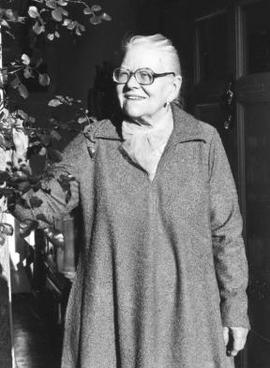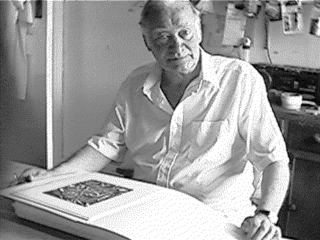Related Research Articles

Catherine Greenaway was an English Victorian artist and writer, known for her children's book illustrations. She received her education in graphic design and art between 1858 and 1871 from the Finsbury School of Art, the South Kensington School of Art, the Heatherley School of Art, and the Slade School of Fine Art. She began her career designing for the burgeoning greetings card market, producing Christmas and Valentine's cards. In 1879 wood-block engraver and printer Edmund Evans printed Under the Window, an instant best-seller, which established her reputation. Her collaboration with Evans continued throughout the 1880s and 1890s.

Thomas Bewick was an English wood-engraver and natural history author. Early in his career he took on all kinds of work such as engraving cutlery, making the wood blocks for advertisements, and illustrating children's books. He gradually turned to illustrating, writing and publishing his own books, gaining an adult audience for the fine illustrations in A History of Quadrupeds.
Gwendolen Mary "Gwen" Raverat, was an English wood engraver who was a founder member of the Society of Wood Engravers. Her memoir Period Piece was published in 1952.

Jane Grigson was an English cookery writer. In the latter part of the 20th century she was the author of the food column for The Observer and wrote numerous books about European cuisines and traditional British dishes. Her work proved influential in promoting British food.

David William Gentleman is an English artist. He studied art and painting at the Royal College of Art under Edward Bawden and John Nash. He has worked in watercolour, lithography and wood engraving, at scales ranging from platform-length murals for Charing Cross Underground Station in London to postage stamps and logos.
Alan Reynolds Stone, CBE, RDI was an English wood engraver, engraver, designer, typographer and painter.
Robert John Gibbings was an Irish artist and author who was most noted for his work as a wood engraver and sculptor, and for his books on travel and natural history. Along with Noel Rooke he was one of the founder members of the Society of Wood Engravers in 1920, and was a major influence in the revival of wood engraving in the twentieth century.

Joan Hassall was an English wood engraver and book illustrator. Her subject matter ranged from natural history through poetry to illustrations for English literary classics. In 1972 she was elected the first woman Master of the Art Workers' Guild and in 1987 was awarded the OBE.
Nora Spicer Unwin was a wood engraver, book illustrator and writer. She was born near London, England, in a family already renowned for publishing and printing circles and for founding three different publishing houses, most notably Allen & Unwin.
Rosemary Kilbourn is a Canadian printmaker, illustrator and stained glass artist known for her work in the wood engraving.
Good Things in England is a compendium of recipes written by Florence White and published in 1932. The book includes regional recipes dating back to the 14th century, with short informative introductions to each section. Good Things in England went on to influence a new generation of culinary writers such as Elizabeth David.
John Lawrence is an English illustrator and wood engraver.
Ethelbert White was an English artist and wood engraver. He was an early member of the Society of Wood Engravers and a founding member of the English Wood Engraving Society in 1925. He also worked in oils and water colour. He was a member of the Royal Watercolour Society, and exhibited regularly at the Royal Academy.
Margaret Pilkington was a British wood-engraver who was active at the beginning of the twentieth century. She was a pupil of Noel Rooke at the Central School of Art and Design and was a member of the Society of Wood Engravers and the Red Rose Guild. She was awarded the OBE in 1956.
Diana Bloomfield, née Wallace was a British wood-engraver, best known for her bookplates and commercial work.
Gwenda Morgan was a British wood engraver. She lived in the town of Petworth in West Sussex.
Barbara Greg was a British artist who illustrated a number of books.
Miriam Macgregor is a British author, illustrator, wood engraver, and fine press compositor. Born in Shillong, Assam, Macgregor was educated at the Guildford School of Art. She began her professional career in the art department of the publisher B. T. Batsford, before becoming a freelance artist. In 1977, she began to work for the fine press publisher, Whittington Press. At the time, all type was set by hand. She still works at the Whittington Press as a compositor and illustrator. She has created images for other fine press publishers, including the Folio Society and Primrose Hill Press. Macgregor is a self-taught wood engraver and member of the Society of Wood Engravers and Royal Society of Painter-Printmakers. She has furnished wood engravings for the horticultural journal, Hortus, in addition to countless wood engravings and pochoir illustrations for books and posters published by the Whittington Press. In addition to the texts she has illustrated, her subjects primarily concern English rural life, farming, architecture, botany, and felines. Macgregor has published several collections of her own images, and curated a collection of contemporary wood engravings of cats, published by Primrose Hill Press in 1999 as Cat cuts.

James Bostock was a British painter. His work was part of the painting event in the art competition at the 1948 Summer Olympics.

Peter Forster was an English wood engraver, artist and printmaker, making illustrations for The Folio Society, The Times, The Observer and Saatchi & Saatchi, together with a number of other publications. He was one of the first wood engravers to use colour in his printmaking. In 2005 he was asked by The Royal Mint to design the £2 coin to recognise the 400th anniversary of the Gunpowder Plot.
References
- 1 2 Brett, Simon (2002). An engraver's globe: wood engraving world-wide in the twenty-first century. London: Primrose Hill Press. p. 379. ISBN 9781901648126. OCLC 253888952.
- ↑ Barker, Nicholas (3 May 2010). "Yvonne Skargon: Artist celebrated for her wood engravings from nature" . Independent. Archived from the original on 7 May 2022. Retrieved 9 March 2019.
- ↑ Jones, Cordelia; Miriam Macgregor; Betty Pennell; Yvonne Skargon (1989). Engraved gardens. Cambridge: Silent Books. p. 56. ISBN 1851830162. OCLC 39977322.
- ↑ Holland, Isobel; Hunter, Lynette; Stoneham, Geraldine (1991). "Bibliography of Jane Grigson's Books". Petits Propos Culinaires . 38. London: Prospect Books: 20–49.
- ↑ Barker, Nicholas (Summer 2010). "Obituary". Book Collector. 59 (2): 307–308. doi:10.1126/science.76.1983.617. PMID 17730029.